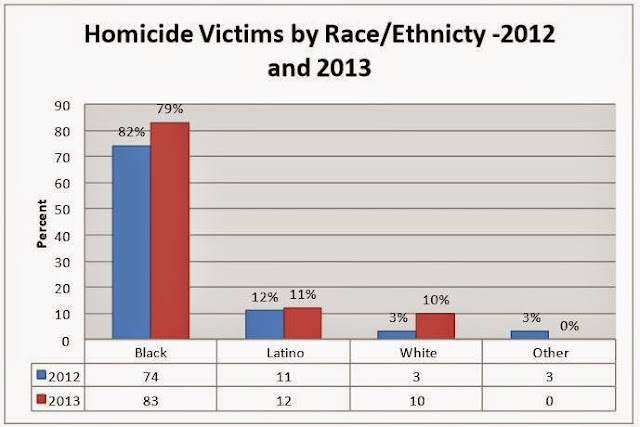***
The following figure is a 2014 year-end homicide map generated by the Milwaukee Police Dept. (http://city.milwaukee.gov/police#.VVXg2JPQOLV). Shading gradations refer to population density:
Total homicides for the city of Milwaukee in 2014 were 92, as per the Milwaukee Journal-Sentinel Homicide Tracker database (http://data.jsonline.com/News/HomicideTracker/Default.aspx), 87% of which were gun homicides.
***
The following 3 images and associated analysis focus on 2014 statewide gun homicide numbers (111 total) and are taken from a January 12, 2015, Urban Milwaukee article by Bill Lueders (http://urbanmilwaukee.com/2015/01/12/gun-homicides-milwaukee-has-two-thirds-of-states-gun-killings/), which is based on data compiled by the WI Center for Investigative Journalism (http://wisconsinwatch.org/category/justice-public-safety/):
***
The following figures are taken from the 2013 Milwaukee Homicide Review Commission annual report (http://city.milwaukee.gov/ImageLibrary/Groups/cityHRC/reports/2013AnnualReport-latest.pdf). This is the latest HRC report available. HRC data reporting begins in 2009 and can be found at http://city.milwaukee.gov/hrc/publications#.VVdE1pPQOLV:
Counting Homicides:
"Homicides can be counted in several ways depending on the definition and intended use of the data. They can be counted by date of incident (injury), date of death or date determined a homicide, victim, incident (may have multiple victim incident), FBI Uniform Crime Report (UCR) definition, or death certificate definition. None of these counts provide inaccurate information; they are just different ways to count homicides. The majority of the data included in this report is based on the UCR definition of homicide, the date of incident, and by victim. In several instances we have provided additional counts, but they are clearly indicated."
***
The following figures are taken from a City of Milwaukee summary paper, dated January 17, 2013, of the then forthcoming 2012 Milwaukee Homicide Review Commission report (http://city.milwaukee.gov/ImageLibrary/Groups/mpdAuthors/Documents/1-17-13HomicideRelease.pdf):
 |
 |
***
The following figures refer to 2012 numbers and are taken from the Marquette University Law School faculty blog, and a blog post Murder and Milwaukee by Mike Gousha on August 15, 2013 (http://law.marquette.edu/facultyblog/2013/08/15/homicides/):
***
The following figures are taken from the 2009 Milwaukee Homicide Review Commission annual report (http://city.milwaukee.gov/ImageLibrary/Groups/cityHRC/reports/2005-2009HomicidesandNonfatalS.pdf):
***
The following homicide numbers, 1980 to 2008, are from a January 2, 2009, article in OnMilwaukee.com titled "Milwaukee murder rate fell by 32 percent in 2008" (http://onmilwaukee.com/buzz/articles/mkemurders2008.html). No specific source is cited in the article, but it is assumed to be data from the Milwaukee Police Dept.. Although these numbers are in general slightly higher than the bar chart the city produced for 1990-2012 (shown above), they do closely mirror the bar chart and are included here as a general measure of homicides between 1980-1989:





























No comments:
Post a Comment